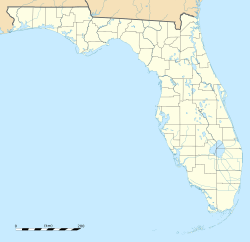Mission San Francisco de Potano facts for kids
Quick facts for kids |
|
|
Mission San Francisco de Potano
|
|
| Location | Gainesville vicinity, Florida, USA |
|---|---|
| NRHP reference No. | 09000251 |
| Added to NRHP | April 30, 2009 |
The Mission San Francisco de Potano was an old Spanish mission in Florida. It was built near Gainesville, Florida, in the United States.
Spanish missionaries called Franciscans started the mission in 1606. Father Martín Prieto and Father Alonso Serrano were the priests who founded it. It was the first "doctrina" (a mission with a priest living there) in Florida west of the St. Johns River. Today, the area is near San Felasco Hammock Preserve State Park. The name "San Felasco" comes from an old way of saying "San Francisco."
In 2007, people found parts of Spanish buildings at the site. This helped confirm where the mission was located. On April 30, 2009, the mission site was added to the U.S. National Register of Historic Places. This means it is an important historical place.
Contents
History of the Mission
The Potano Native American people and the Spanish were not friends for about 30 years. This was after the Spanish built St. Augustine in 1565.
Peace and New Missions
In 1597, leaders from the Potano and other Western Timucuan tribes promised to be loyal to the Spanish governor. His name was Gonzalo Méndez de Canço. They met him in St. Augustine. Franciscan missionaries started visiting Western Timucuan villages that same year.
However, a rebellion in another area called Guale Province stopped missionary work in Florida for ten years. Missionaries still visited sometimes, but they could not build permanent missions. Even though the Native American leaders asked for missions, they were not built right away.
More Franciscan missionaries arrived in 1605. This allowed them to start building permanent missions in the Western Timucua area. The Mission San Francisco de Potano was the first of these, started in 1606.
Early Challenges
Soon after Father Prieto and Father Serrano started San Francisco, Father Prieto also built two other nearby missions. These were Santa Ana de Potano and San Miguel de Potano.
But the villagers at San Francisco de Potano were not happy. This made Father Prieto go back to St. Augustine. Because of this, San Francisco became a "visita." This means it was a mission without a priest living there all the time. Father Serrano, who lived at San Miguel de Potano, would visit it.
A fourth mission, San Buenaventura de Potano, was built nearby a little later. At first, these four Potano missions served about 1,200 Native Americans. About 400 of them were at San Francisco.
Population Decline and Abandonment
Sadly, the number of Potano people quickly went down. This was because of many diseases that spread through the area. Because of this, the San Miguel and San Buenaventura missions were closed after only a few years. The people who survived moved to San Francisco and Santa Ana.
Later in the 1600s, the Spanish had cattle ranches in Florida. At least one of these ranches was near San Francisco de Potano.
Gabriel Diaz Vara Calderón, who was a Bishop from Cuba, visited the Florida missions in 1674 and 1675. He wrote that the San Francisco mission was empty. However, a mission at San Francisco did exist again at the start of the 1700s.
Starting in the 1680s, and even more after 1700 during Queen Anne's War, the English from the Province of Carolina and their Native American allies attacked Spanish missions in Florida many times.
After the mission buildings at Santa Fé de Toloca were destroyed in 1702, that mission joined with San Francisco in 1703. By 1704, San Francisco was a strong, protected place. It was one of the few Spanish outposts left west of the St. Johns River.
The remaining Native Americans at San Francisco de Potano moved east of the St. Johns River in 1706. This meant the mission was abandoned exactly 100 years after it was first built.



